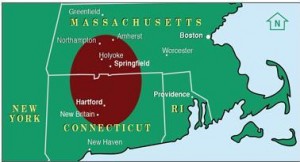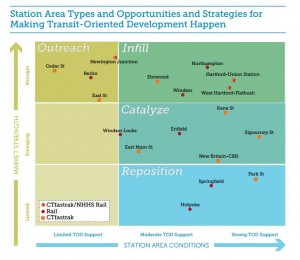With CTfastrak and the New Haven-Hartford-Springfield Rail projects set to open in 2015 and 2016, respectively, discussion about future development in the area is ramping up. Recently, the Capitol Region Council of Governments, the Pioneer Valley Planning Commission and the Sustainable Knowledge Corridor Consortium commissioned a report detailing Transit Oriented Development (TOD) opportunities around these bus and train transit stations.
The report, titled Making it Happen: Opportunities and Strategies for Transit-Oriented Development in the Knowledge Corridor, analyzes which station areas on those future lines are most ready for development and what needs to be done to further encourage development at others.
The need for responsible strategies to deal with future development couldn’t be clearer. The area to be served by these future systems, also known as the “Knowledge Corridor”, is a large and long-interconnected area with a population of 1.8 million, more than 45,000 companies, a labor force of 1.1 million people, 32 colleges and universities and more than 120,000 students.
[Source: New England’s Sustainable Knowledge Corridor]
This density of people and employers, especially schools and students, provides a great opportunity to utilize transit as rapid and reliable means of transportation to enhance the economy.
[Source: Making it Happen: Opportunities and Strategies for Transit-Oriented Development in the Knowledge Corridor, Executive Summary, September 2013.]
There is a great deal of short term potential in the Connecticut portion of the Knowledge Corridor. First, there are two stations that are on both the NHHS Rail and CTfastrak corridor, and one CTfastrak station, that are “infill,” what the report characterizes as having “the strongest likelihood of new TOD in the near-term, due to their stronger market conditions and very supportive urban form.”
There are another four Connecticut stations where the Consortium found strong market demand but identified a need for creating a more TOD-supportive environment around the stations. Some ways of doing this suggested in the report include reforming zoning regulations and increasing state government technical assistance to municipal governments.
Meanwhile, six other stations have the appropriate urban form to support TOD but are lacking in near-term market conditions, which can be improved by working with anchor institutions and providing incentives to firms that locate in the new station areas. The report cites the Illinois Business Location Efficiency Incentive Act as a model. A regional example not mentioned in the report is New Jersey’s Economic Opportunity Act which provides similar incentives.
In order for Connecticut to grow economically into the 21st century and beyond, the state must take advantage of the development opportunities along the Knowledge Corridor, potential which Massachusetts Secretary of Housing and Urban Development Gregory P. Bialecki and Commissioner of the Connecticut Department of Economic Opportunity and Community Development Catherine Smith dubbed “unrealized assets”.



[…] Malloy was on target when advancing the New Haven-Hartford-Springfield Line and CTfastrak projects. However, with only 2 percent of the Connecticut State Transportation Improvement […]
[…] more than 80 percent of commuters currently drive alone. The rail line is also expected to bring transit-oriented development to areas near stations, not just in Knowledge Corridor’s major cities, but also in the […]
[…] development on the rise — Following calls from Tri-State to leverage Connecticut’s new transit infrastructure for smarter redevelopment, […]